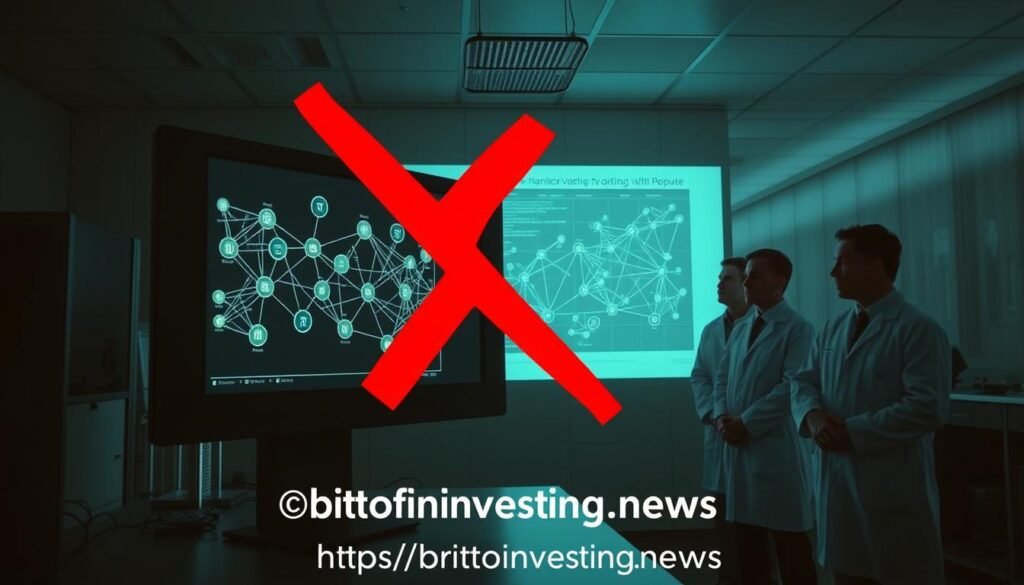Blockchain Bites: Data Unions, Hard Forks and Citi Analyst’s 300K BTC Forecast
Surprising fact: one high-profile forecast once suggested bitcoin could eclipse $318,000 by year-end, a claim that reshaped market debate and pushed institutions to re-evaluate treasury strategy.
This short explainer puts that projection in context for U.S. readers by linking macro signals, protocol governance, and security incidents that mattered at the time.
We summarize why Citibank’s comparison of bitcoin to gold in the 1970s hit headlines, while Fidelity’s Ria Bhutoria answered common criticisms about settlement, scarcity, and censorship resistance.
Alongside those views, platform moves—from Galaxy Digital’s acquisitions and asset inflows to flash-loan exploits that exposed DeFi risk—helped shape sentiment in the largest cryptocurrency market.
Technical debates, like the limits of blockchain voting and the fallout from chain splits, show how governance and coordination can create rapid price and liquidity swings.
Key Takeaways
- Big forecasts can change expectations, but markets react to signals from platforms, research, and security events.
- Institutional research and acquisitions influenced asset flows and risk appetite during this period.
- DeFi exploits and protocol fixes highlighted practical limits to some crypto systems.
- Chain governance fights caused short-term market dislocations and exchange interventions.
- Readers should weigh macro liquidity, technical design, and verified data when reading price reports.
Macro moves and models: a Citibank managing director thinks bitcoin could break out
A Citibank managing director framed bitcoin’s setup as a historical comparison to gold, arguing that broad quantitative easing might interact with fixed supply to create asymmetric upside.
The report laid out the mechanics: limited issuance, rising institutional demand, and heavy liquidity as potential drivers of higher price outcomes for the largest cryptocurrency.
Technical comparison to gold
The report compared bitcoin’s monetary traits to gold in the 1970s and suggested a scenario where easing amplifies asset flows into scarce stores of value.
Negative-yielding bonds and institutional appetite
Negative-yielding debt hit multitrillion-dollar levels, pushing some firms to seek alternative stores of value. That narrative helped explain why certain firms and institutional managers rotated into bitcoin-like assets.
Data unions in context
Separately, user-controlled data and monetization models were proposed as complements to custody and settlement rails. Platforms that combine custody, futures liquidity, and user data services can broaden institutional access.
| Claim | Source | Implication |
|---|---|---|
| Gold-style monetary comparison | Citibank managing director report | Scenario-based upside for bitcoin |
| Long-range targets lack edge | ClassicMacro critique | Risk management caution |
| Institutional rebuttals on volatility | Fidelity research | Settlement and scarcity strengthen thesis |
| Platform maturation | Galaxy Digital acquisitions | Improved services, liquidity, and assets |
Takeaway: the report argues that macro and structural features could push price higher, but these are model scenarios. Investors should cross-check on-chain activity, futures depth, and platform disclosures before acting.
Researchers resoundingly reject blockchain-based voting amid security and governance concerns
A recent MIT study finds that modern cryptography does not fix the real-world threats that make digital voting unsafe for public elections.
The report says the biggest problems are not ledger integrity but voter coercion and persistent key management failures. Cryptography cannot stop a caregiver, employer, or coercer from forcing a vote.

Permissioned blockchains and zero-knowledge proofs add technical layers but also new attack surfaces. Researchers resoundingly reject blockchain-based e-voting for national-scale contests because clients, devices, and recovery processes remain weak.
- Core threat: coercion at the edge and private key theft.
- Complexity cost: added components without solving human risks.
- Operational takeaway: service providers must prioritize device security and recovery before any rollout.
“I would not trust a blockchain system for even a county-fair jellybean count.”
| Issue | Why it matters | Practical effect |
|---|---|---|
| Voter coercion | Off-chain pressure bypasses cryptography | Undermines ballot secrecy |
| Key custody | Loss or theft breaks access | Large-scale disenfranchisement risk |
| System complexity | Permissioned chains & ZK add components | More implementation bugs and attack vectors |
Bottom line: researchers resoundingly reject blockchain-based voting for public elections after hours and months of testing. For now, cryptographic proofs can help audits in small systems, but they do not replace layered, observable election procedures.
Bitcoin Cash latest: the hard fork that wasn’t, exchange pauses, and market signals
A proposed developer subsidy turned a routine upgrade into a high-stakes contest over which chain would survive.
Inside the split
The Infrastructure Funding Plan — an 8% miner “tax” proposed by Amaury Séchet — triggered governance friction across the community.
Roger Ver pushed back, arguing the plan risked centralization and revived critiques of fork-first decision making.
Hash power and signaling
BCHN gained an early lead, extending a 129-block advantage while miners largely avoided BCHA. That gap signaled strong technical resistance to the ABC chain.
Futures-style signaling—client adoption, miner statements, and derivative chatter—often predicts which branch will hold before price fully reflects the outcome.
Service responses and market effects
Exchanges and crypto services paused deposits and withdrawals for hours to limit reorg and double-spend risk.
Most services announced support for the chain with dominant hash power, which helped stabilize tickers and user balances.
Market reaction
Volatility rose and institutional vehicles reacted quickly: Grayscale’s Bitcoin Cash Trust registered an outflow tied to uncertainty.
Practical advice: monitor service-status pages, confirm chain IDs, and wait for extra confirmations after a fork.
| Item | Outcome | Why it mattered |
|---|---|---|
| Miner “tax” proposal | Governance split | Triggered competing implementations |
| Hash power (BCHN vs BCHA) | BCHN lead (129 blocks) | Technical dominance reduces alternative liquidity |
| Exchange pauses | Temporary service freeze | Protects users from reorgs and double-spends |
| Market impact | Price volatility & trust pressure | Institutional products mirror on-chain outcomes |
blockchain-bites-data-unions-hard-forks-and-one-citi-analysts-case-for-300k-btc — Conclusion
The story ends with a clear point: bold price scenarios prompt industry responses that reveal strengths and gaps. A citibank managing director comparison pushed debate about what bitcoin could do under heavy liquidity, and firms reacted by improving custody, trading, and risk controls.
The report served as a lens for news and blogs to test models against reality. Institutional buys, negative-yield dynamics, and Galaxy Digital’s moves showed how the largest cryptocurrency drew serious capital and services over time.
At the same time, researchers flagged limits: blockchains help settlement and value transfer, but they do not solve human risks in voting or custody. Watch market depth, exchange policies, and service reliability when evaluating price narratives that can shift in hours.
Use a data-driven, disciplined approach. Cross-check reports, audits, and platform disclosures. Directors and managing teams shape liquidity and standards, so measure claims against transparent metrics and long-term value.
FAQ
What is the Citibank managing director’s view on bitcoin’s potential breakout?
The managing director at Citibank argues that macro forces, technical features, and shifting institutional flows could drive substantial upside for bitcoin. Their report compares bitcoin to gold as a scarce digital asset and models scenarios in which rising institutional demand and negative-yielding sovereign bonds push capital into crypto, supporting a long-term price case above current levels.
How does the Citibank report compare bitcoin to gold?
The report treats bitcoin as a digital store of value with capped supply, similar to gold. It analyzes market depth, liquidity, and institutional allocation assumptions to build a stylized valuation that supports a multi-hundred-thousand-dollar outcome in a bull scenario for the largest cryptocurrency market.
Why would negative-yielding bonds increase institutional interest in crypto assets?
Negative or very low bond yields reduce real returns on traditional safe assets. That environment encourages firms and investors to seek alternative stores of value and return, including digital assets. Institutions may allocate to crypto for yield diversification, inflation hedging, and portfolio protection when bond returns are unattractive.
What are data unions and how do they relate to crypto platforms?
Data unions are frameworks that treat user data as labor and enable collective monetization via token incentives. In crypto infrastructure, they align user contributions, governance, and revenue sharing through smart contracts and decentralized platforms, creating new market infrastructure for data-centric services.
Why are researchers rejecting blockchain-based voting systems?
Academics and security experts cite coercion risks, fragile key management, and privacy challenges as core problems. They find that many proposed systems rely on unrealistic threat models, and that existing permissioned blockchains or advanced cryptography like zero-knowledge proofs do not fully eliminate operational and governance vulnerabilities.
What key vulnerabilities undermine blockchain voting proposals?
Major weaknesses include voter coercion or vote-selling, single points of failure in key custody, limited auditability without privacy loss, and governance dilemmas in permissioned ledgers. These practical issues make it difficult to preserve both verifiability and voter secrecy at scale.
How do these voting concerns affect crypto service providers and public systems?
Providers face increased scrutiny on security design, liability, and compliance. Public systems are reluctant to adopt blockchain-based voting without clear, peer-reviewed solutions to coercion and key management. Many researchers recommend traditional cryptographic and process controls instead of wholesale blockchain adoption for elections.
What happened with the recent Bitcoin Cash governance dispute described as a “hard fork that wasn’t”?
A proposed miner fee change, framed as a miner “tax,” generated governance friction and talk of a hard fork. Mining pools and developers engaged in signaling, but coordinated resistance and exchange precautions led to a de‑escalation, so the expected chain split did not fully materialize across the network.
How does hash power signaling work in BCH disputes, and what do BCHN vs. BCHA represent?
Miners can signal chain preference by directing hash power to a given client implementation. BCHN and BCHA were competing implementations representing different governance choices. Higher sustained hash power for one chain increases its practical security and reduces the chance of a persistent split, affecting trader sentiment and futures-style indicators.
Why did some exchanges pause Bitcoin Cash functionality during the dispute?
Exchanges paused deposits, withdrawals, or trading to protect users from replay attacks, chain splits, or unsupported outcomes. Pauses give operators time to assess which chain will be recognized, update support, and reduce the risk of incorrect crediting of user balances across competing chains.
How do forks and governance fights influence market volatility and asset trust?
Governance uncertainty and potential forks increase short-term volatility as traders price in different outcomes. Repeated disputes can erode trust in project governance, reducing long-term confidence and impacting downstream assets that rely on network stability.
Are blockchain platforms suitable for widely used public services beyond voting?
Blockchains can excel at transparency, immutable logging, and tokenized incentives for specific use cases. However, critical public services require rigorous security, privacy protections, and governance models. Many researchers recommend careful hybrid designs or off-chain mechanisms rather than naive on-chain implementations.
What should investors watch in the largest cryptocurrency market amid these developments?
Monitor on-chain metrics, institutional flow data, regulatory signals, and governance events like proposed forks. Also watch derivatives markets and exchange behavior for clues on market sentiment and technical resistance or support levels that can influence price and volatility.


